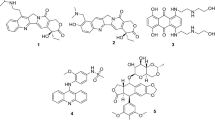Summary
Fluoroquinolone-class agents selectively target the bacterial type IIA topoisomerases DNA gyrase and topoisomerase IV, with a few exceptions that target eukaryotic type IIA topoisomerases. Fluoroquinolones bind and stabilize type IIA topoisomerase-DNA covalent complexes that contain a double-strand break. This unique mode of action is referred to as ‘topoisomerase poisoning’. We discovered that two novel fluoroquinolones having aryl functionality at the N-1 position, UITT-3-217 (217) and UITT-3-227 (227), could inhibit the catalytic activity of human topoisomerase II without stabilizing topoisomerase-DNA complexes, i.e., without poisoning it. Surprisingly, these compounds are more effective in inhibiting the catalytic activities of human and bacterial topoisomerase I. The National Cancer Institute’s 60 human tumor cell lines screen revealed significant anti-proliferative activities with 217 and 227 against the majority of 60 cancer cell lines. A proof of concept in vivo efficacy study using an HT-29 xenograft model of human colorectal cancer showed that 217 could inhibit the proliferation of human colorectal cancer cells to a degree comparable to fluorouracil in mice. Although 227 also exhibited anti-proliferative activity, it was not as effective as 217 in this xenograft model. These novel fluoroquinolones may serve as promising lead compounds for the development of new anticancer drugs.


Similar content being viewed by others
References
Corbett KD, Berger JM (2004) Structure, molecular mechanisms, and evolutionary relationships in DNA topoisomerases. Annu Rev Biophys Biomol Struct 33:95–118
Chen SH, Chan NL, Hsieh TS (2013) New mechanistic and functional insights into DNA topoisomerases. Annu Rev Biochem 82:139–170
Pommier Y, Sun Y, Huang SN, Nitiss JL (2016) Roles of eukaryotic topoisomerases in transcription, replication and genomic stability. Nat Rev Mol Cell Biol 17:703–721
Precision Medicine. https://www.cancer.gov/about-cancer/treatment/types/precision-medicine. Accessed August 2, 2018
Nitiss JL (2009) Targeting DNA topoisomerase II in cancer chemotherapy. Nat Rev Cancer 9:338–350
Pommier Y (2013) Drugging topoisomerases: lessons and challenges. ACS Chem Biol 8:82–95
Delgado JL, Hsieh CM, Chan NL, Hiasa (2018) Topoisomerases as anticancer targets. Biochem J 475:373–398
Pendleton MJ, RHJr L, Felix CA, Grimwade D, Osheroff N (2014) Topoisomerase II and leukemia. Ann N Y Acad Sci 1310:98–110
Robinson MJ, Martin BA, Gootz TD, McGuirk PR, Moynihan M, Sutcliffe JA, Osheroff N (1991) Effects of quinolone derivatives on eukaryotic topoisomerase II. A novel mechanism for enhancement of enzyme-mediated DNA cleavage. J Biol Chem 266:14585–14592
Towle TR, Kulkami CA, Oppegard LM, Williams BP, Picha TA, Hiasa H, Kerns RJ (2018) Design, synthesis, and evaluation of novel N-1 fluoroquinolone derivatives: probing for binding contact with the active site tyrosine of gyrase. Bioorg Med Chem Lett 28:1903–1910
Oppegard LM, Nguyen T, Ellis KC, Hiasa H (2012) Inhibition of human topoisomerases I and II by Simocyclinone D8. J Nat Prod 75:485–489
NCI-60 Screening Methodology. https://dtp.cancer.gov/discovery_development/nci-60/methodology.htm. Accessed August 2, 2018
Wohlkonig A, Chan PF, Fosberry AP, Homes P, Huang J, Kranz M, Leydon VR, Miles TJ, Pearson ND, Perera RL, Shillings AJ, Gwynn MN, Bax BD (2010) Structural basis of quinolone inhibition of type IIA topoisomerases and target-mediated resistance. Nat Struct Mol Biol 17:1152–1153
Laponogov I, Pan XS, Veselkov DA, McAuley, KE, Fisher LM. Sanderson MR (2010) Structural basis of gate-DNA breakage and resealing by type II topoisomerases. PLoS One 5:e11338
Blower TR, Williamson BH, Kerns RJ, Berger JM (2016) Crystal structure and stability of gyrase-fluoroquinolone cleaved complexes from Mycobacterium tuberculosis. Proc Natl Acad Sci U S A 113:1706–1713
Fortune JM, Osheroff N (1998) Merbarone inhibits the catalytic activity of human topoisomerase IIα by blocking DNA cleavage. J Biol Chem 273:17643–17650
German N, Malik M, Rosen JD, Drlica K, Kerns RJ (2008) Use of gyrase resistance mutants to guide selection of 8-methoxy-quinazoline-2,4-diones. Antimicrob Agents Chemother 52:3915–3921
Palu G, Valisena S, Ciarrochi G, Gatto B, Palumbo M (1992) Quinolone binding to DNA is mediated by magnesium ions. Proc Natl Acad Sci U S A 89:9671–9675
Boger DL, Tse WC (2001) Thiazole orange as the fluorescent intercalator in a high resolution fid assay for determining DNA binding affinity and sequence selectivity of small molecules. Bioorg Med Chem 9:2511–2518
Treatment of Colon Cancer, by Stage. https://www.cancer.org/cancer/colon-rectal-cancer/treating/by-stage-colon.html Accessed August 2, 2018
Acknowledgements
We would like to thank Margaret A. Mysz, Lia G. Coicou, Brenda L. Koniar, and Nicole A. Larson for expert assistance.
Funding
This work was supported in part by the National Institutes of Health (NIH) grant R01 AI087671 (to RJK), the NIH’s National Center for Advancing Translational Sciences grant UL1TR002494 (to HH), and the National Cancer Institute’s Developmental Therapeutic Program. We also received support from the University of Minnesota’s Center for Translational Medicine and the Masonic Cancer Center (to RJS). TRT acknowledges support of the NIH Predoctoral Training Program in Pharmacological Sciences (GM067795), the American Foundation for Pharmaceutical Education Predoctoral Fellowship Program, and the American Chemical Society Division of Medicinal Chemistry Fellowship sponsored by Richard B. Silverman-2012 Predoctoral. CAK and JLD acknowledge support of training fellowships from the University of Iowa Center for Biocatalysis and Bioprocessing and of the NIH-sponsored Predoctoral Training Program in Biotechnology (GM008365). The content of this article is solely the responsibility of the authors and does not necessarily represent the official views of the National Center for Advancing Translational Sciences.
Author information
Authors and Affiliations
Corresponding author
Ethics declarations
Conflict of interest
The authors declare no competing financial interest.
Ethical approval
This article does not contain any studies with human participants performed by any of the authors. The animal studies were approved by the University of Minnesota Institutional Animal Care and Use Committee.
Informed consent
For this type of study, formal consent is not required.
Electronic supplementary material
ESM 1
(DOCX 1313 kb)
Rights and permissions
About this article
Cite this article
Oppegard, L.M., Delgado, J.L., Kulkarni, C.A. et al. Novel N-1 substituted fluoroquinolones inhibit human topoisomerase I activity and exhibit anti-proliferative activity. Invest New Drugs 37, 378–383 (2019). https://doi.org/10.1007/s10637-018-0666-x
Received:
Accepted:
Published:
Issue Date:
DOI: https://doi.org/10.1007/s10637-018-0666-x




